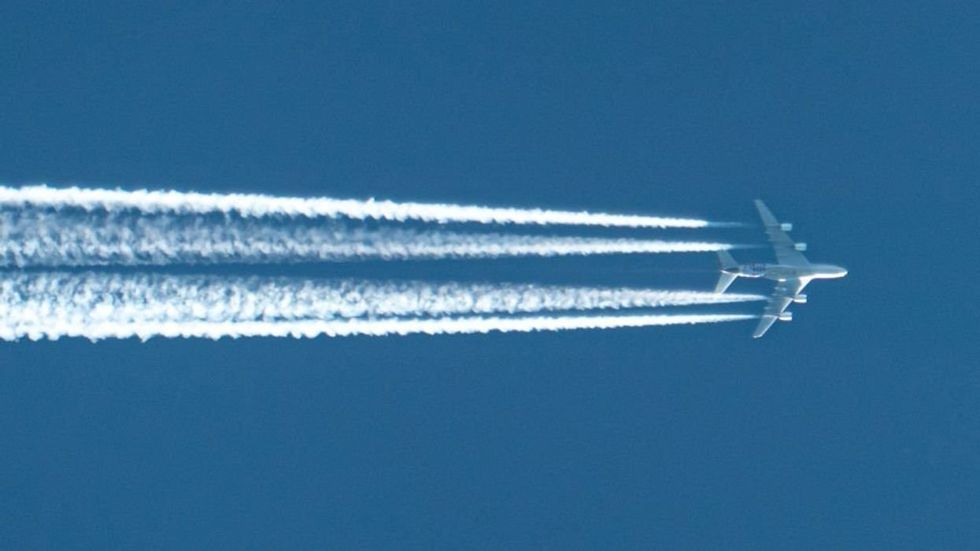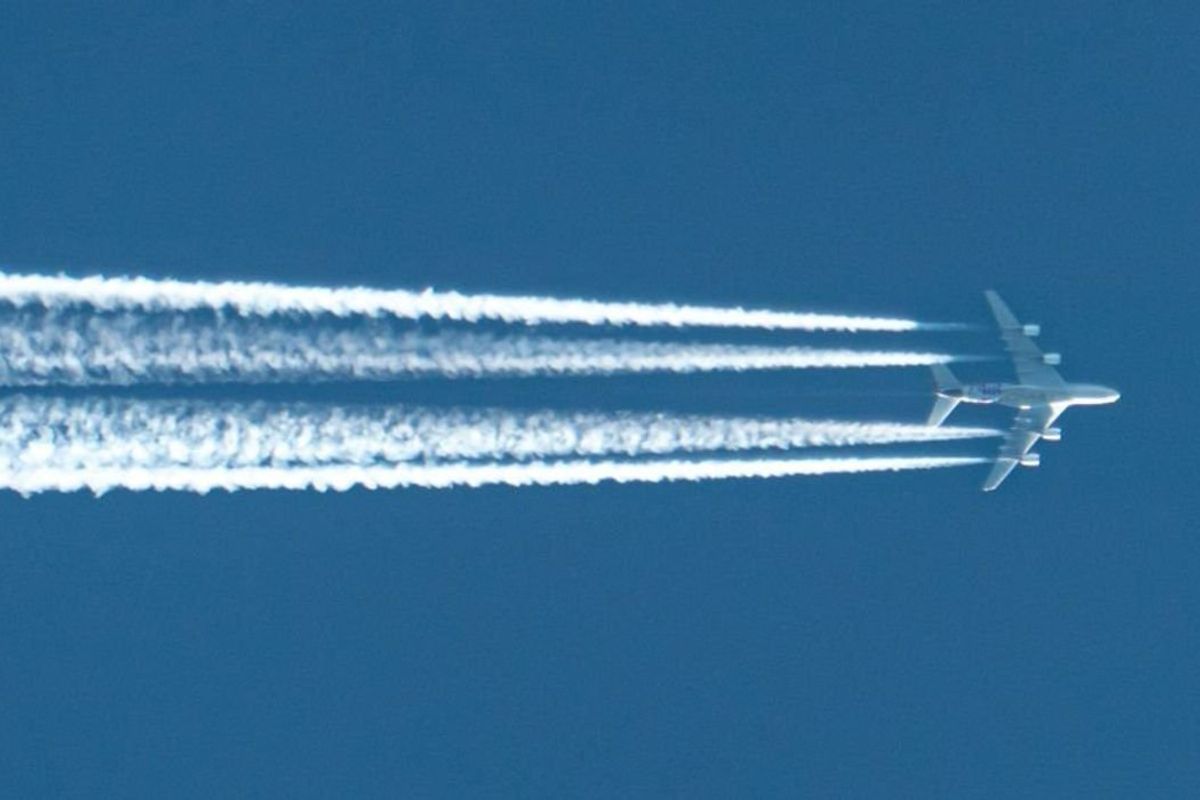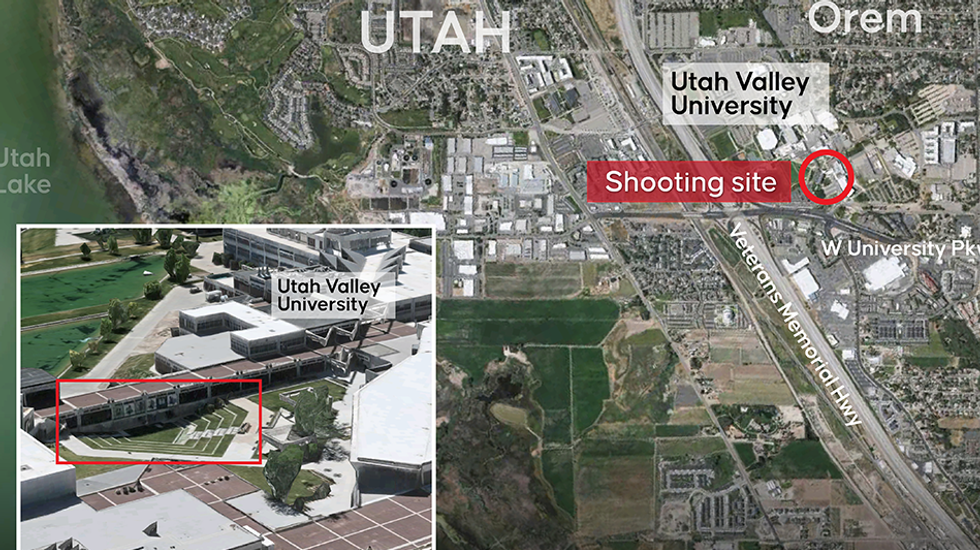Researchers advocate using existing aircraft, sulfur to block sunlight amid UK-backed trials


A study published Monday in the American Geophysical Union's peer-reviewed journal Earth's Future suggested, largely on the basis of different aerosol injection simulations, that it might be worthwhile using existing commercial jetliners to pollute the skies with toxic sulfur dioxide particles in order to dim the sun and thereby cool the planet.
Researchers from University College London indicated that weaponizing jets like the Boeing 777F — roughly 36 of which are produced a year — against the sun would would mean "lower technical barriers," a potential increase in "the number of actors able to produce a substantial global cooling using SAI [stratospheric aerosol injection]," and an earlier potential start date for this master plan.
They acknowledged, however, that the use of existing aircraft for the purposes of SAI would be less efficient than having specialized aircraft flying at altitudes of over 12 miles to conduct dumps and more likely to generate undesirable side effects.
'Dousing our citizens, our waterways and landscapes with toxins.'
According to the study, "Low-altitude SAI with high-latitude and seasonal injection, could achieve a substantial global cooling effect using existing large jetliners with a service ceiling of 13 km."
The researchers estimated "a global cooling of 0.6°C for an injection of 12 Tg at 13 km altitude at 60° North and South, in the local spring and summer." In other words, climate meddlers might be able to cool the planet down just over half a degree with a seasonal dumping of over 13.2 million tons of sulfur at the latitudes of Anchorage, Alaska, and the southern tip of South America.
In effect, they would be emulating the 1991 eruption of Mt. Pinatubo, which injected 20 million tons of sulfur dioxide into the stratosphere and caused a rapid half-degree drop in global temperatures. According to NASA, this drop lasted for two years until the sulfate dropped out of the atmosphere.
"We find this strategy would have only 35% of the forcing efficiency of a conventional high-altitude-subtropical injection, which would lead to a proportionate increase in the side-effects of SAI per unit cooling, such as human exposure to descending particulate matter," wrote the researchers.
In addition to "dousing our citizens, our waterways and landscapes with toxins," as Health and Human Services Secretary Robert F. Kennedy Jr. put it last month, the embrace of this strategy might increase the "risk of unilateral or poorly planned deployment," said the researchers.
Dozens of U.S. states have taken steps to ban geoengineering and weather modification activities. Earlier this month, the Florida Senate passed legislation that would protect the Sunshine State's skies from climate alarmists' shadowy designs. The United Kingdom has gone in the other direction.
Blaze News recently reported that the U.K. is throwing its approval and weight behind solar geoengineering experiments to be conducted by the Advanced Research and Invention Agency.
'That means that we would need to use three times the amount of aerosol to have the same effect on global temperature.'
Even with America's geoengineering bans, the homeland could potentially be impacted by foreign SAI experiments should the U.K. or another national entity decide to unilaterally execute SAI operations ahead of schedule, thanks to the embrace of modified jetliners.
A 2017 study published in Nature Communications indicated that SAI only in the northern hemisphere might increase droughts, hurricanes, and storms elsewhere, and concluded that "the impacts of SG would not be entirely confined to the perturbed region."
Lead author Alistair Duffey on the new study in Earth's Future told Phys.org, "Solar geoengineering comes with serious risks and much more research is needed to understand its impacts. However, our study suggests that it is easier to cool the planet with this particular intervention than we thought. This has implications for how quickly stratospheric aerosol injection could be started and by who."
"There are downsides to this polar low-altitude strategy," continued Duffey. "At this lower altitude, stratospheric aerosol injection is about one-third as effective. That means that we would need to use three times the amount of aerosol to have the same effect on global temperature, increasing side effects such as acid rain. The strategy would also be less effective at cooling the tropics, where the direct vulnerability to warming is highest."
Duffey added that "climate change is a serious problem," intimating that policymakers might weight the perceived threat of changing weather patterns as more concerning than the threats posed dumping chemicals overhead and generating acidic precipitation.
Columbia University's Climate School noted last April, "Studies show that stratospheric aerosol injection could weaken the stratospheric ozone layer, alter precipitation patterns, and affect agriculture, ecosystem services, marine life, and air quality. Moreover, the impacts and risks would vary by how and where it is deployed, the climate, ecosystems, and the population."
Matthew Henry of the University of Exeter, one of Duffey's co-authors, made clear to Phys.org that even with solar geoengineering, climate alarmists will still want to continue with their project of social engineering: "Stratospheric aerosol injection is certainly not a replacement for greenhouse gas emission reductions as any potential negative side effects increase with the amount of cooling: we can only achieve long-term climate stability with net zero."
Like Blaze News? Bypass the censors, sign up for our newsletters, and get stories like this direct to your inbox. Sign up here!
Originally Published at Daily Wire, Daily Signal, or The Blaze
What's Your Reaction?
 Like
0
Like
0
 Dislike
0
Dislike
0
 Love
0
Love
0
 Funny
0
Funny
0
 Angry
0
Angry
0
 Sad
0
Sad
0
 Wow
0
Wow
0













































































